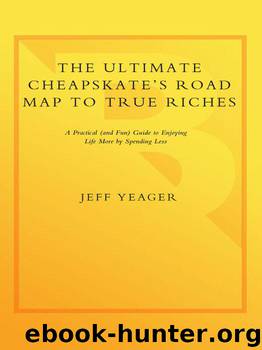The Ultimate Cheapskate's Road Map to True Riches: A Practical (and Fun) Guide to Enjoying Life More by Spending Less by Yeager Jeff

Author:Yeager, Jeff [Yeager, Jeff]
Language: eng
Format: epub
Publisher: Crown Publishing Group
Published: 2007-12-25T21:00:00+00:00
Keep the Dream from Becoming a Nightmare
As you probably already know, your house, if you choose to buy one, will almost certainly be the single largest purchase you make in your lifetime. The traditional rule of thumb used by mortgage bankers was that no more than 30 percent of your household income should be spent on housing. But according to the U.S. Department of Housing and Urban Development, housing costs now consume 50 percent or more of the incomes of more than twelve million American families. Even if you don’t buy one, housing is still likely to be the single most expensive commodity you’ll pay for over the course of your life.
I’m all in favor of striving to achieve the original American dream of homeownership. Experts will tell you that Americans who buy homes amass an average of thirty to forty times more wealth over their lifetimes than people who don’t. Interpreting that statistic strikes me as a little tricky, as clearly homeownership is both a cause and an effect of wealth—that is, wealthier people are in a better position to buy a house in the first place, and buying a house in turn usually generates more wealth through appreciation. Regardless of interpretation, however, few, if any, financial pundits advise against trying to buy rather than rent housing, and I wholeheartedly agree with that.
But if owning your own home was the original American dream, today the new American dream is to own (excuse me, pay interest toward) your own castle. It’s this new American dream that I rail against.
Between 1950 and 1993 the average size of a new house built in the United States increased by nearly 90 percent (1,100 versus 2,060 square feet). That’s a big jump, but even bigger when you factor in the decreasing household / family size during that same period. In 1950 it was one American per 312 square feet of residential space, but that increased by about 140 percent to 742 square feet by 1993. And it looks as if the trend of supersizing the family homestead is continuing with no end in sight.
Younger generations today often complain that they’ll never be able to afford to buy a house, that home prices are just too high. But when you factor in inflation ($1 in 1950 was equivalent to $7.75 in 2005), that 1,100-square-foot house that cost about $14,400 in 1950 would have cost $112,375 in 2005. That’s probably not far off what the actual figures would have been and certainly not reflective of any extraordinary increase in housing costs compared with other costs, outside of normal inflation.
But what has changed is our desire for more, for a bigger house. In 2005 the median cost of an average new home—a 2,000-plus-square-foot castle—was actually around $240,000, roughly double in price and double in size of the back-of-the-envelope example given above. It looks to me as if it’s our appetites, not housing prices, that have shot up so dramatically in recent years.
So we want to own a castle, not just a house as our grandparents did.
Download
This site does not store any files on its server. We only index and link to content provided by other sites. Please contact the content providers to delete copyright contents if any and email us, we'll remove relevant links or contents immediately.
| Budgeting & Money Management | College & Education Costs |
| Credit Ratings & Repair | Retirement Planning |
The Compound Effect by Darren Hardy(8786)
Tools of Titans by Timothy Ferriss(8186)
Nudge - Improving Decisions about Health, Wealth, and Happiness by Thaler Sunstein(7547)
Win Bigly by Scott Adams(7078)
Deep Work by Cal Newport(6855)
Rich Dad Poor Dad by Robert T. Kiyosaki(6362)
Pioneering Portfolio Management by David F. Swensen(6208)
Principles: Life and Work by Ray Dalio(6176)
The Barefoot Investor by Scott Pape(5685)
Digital Minimalism by Cal Newport;(5633)
Grit by Angela Duckworth(5492)
The Slight Edge by Jeff Olson(5334)
Discipline Equals Freedom by Jocko Willink(5256)
The Motivation Myth by Jeff Haden(5142)
You Are a Badass at Making Money by Jen Sincero(4812)
The Four Tendencies by Gretchen Rubin(4532)
Eat That Frog! by Brian Tracy(4409)
The Confidence Code by Katty Kay(4175)
Bullshit Jobs by David Graeber(4068)
